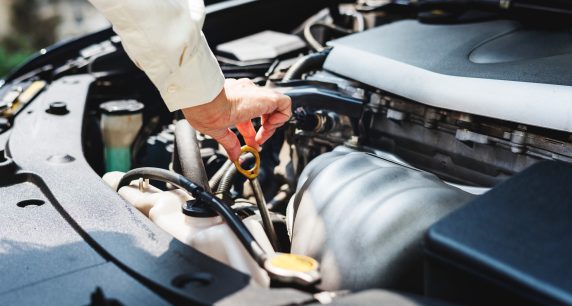How and When Should I Change My Transmission Fluid?

Transmission fluid is the lifeblood of your transmission. Transmission fluid acts as a lubricant to help keep everything running smoothly and efficiently. That is, of course, assuming that you have good levels of clean transmission fluid in your transmission. To ensure this at all times, you should regularly change your transmission fluid. But how and when is sometimes a matter of debate.

TRANSMISSION FLUID
There are many transmission problems that can be caused or exacerbated by an inadequate quantity or quality of transmission fluid. If you are driving around with either very old or not enough transmission fluid (or worse still, both), you are accelerating the wear and damage on components within your transmission. Taking the time to change it out when necessary could save you loads of time and money in the end by extending the lifespan of your transmission.
WHEN TO CHANGE YOUR TRANSMISSION FLUID
Just when you should change out your transmission fluid will vary depending on what kind of transmission you have, what vehicle you drive, where you drive, how you drive, and how much your drive. But for a very rough estimate, for an automatic transmission, you ought to change your fluid every 50,000-100,000 KM. 100,000 KM in the far reaches of the acceptable range, mind you. The typical service interval every 50,000 KM or every two years.
For manual transmissions, you should change the fluid about every 50,000-90,000 KM , however, under intense use, some manufacturers suggest changing it as often as every 25,000 KM. The reason for the difference between automatic and manual transmissions is because they take different fluids. Automatic transmissions take –get this– automatic transmission fluid. For manuals, it is a bit more complicated. They might take any of a variety of oils: regular motor oil, heavyweight hypoid gear oil, or even automatic transmission fluid in some cases. Your owner’s manual will tell you which is best for your transmission.
HOW TO CHANGE YOUR TRANSMISSION FLUID?

The operation is more complicated on automatic gearboxes than on manual gearboxes.
- Get your vehicle ready
To make your engine oil less viscous so that it drains out more easily when changing it, it is advisable to carry out this operation after having used your vehicle for more than 10 minutes. Make sure your vehicle is on a flat and horizontal surface. Turn the engine off and apply the handbrake.
There should be enough space under the car for you to be able to access the oil sump. If there isn’t, you may use a jack to raise the car, and then stabilize it was jack stands.
Never get under the car when it is only held up by the jack – it is very unstable. The purpose of the jack stands is to reduce this instability. Refer to the manufacturer’s user manual to find out where to place them.
- Check the filling cap
Before you change your oil, make sure that the filling cap is not jammed and that you will be able to fill your sump once you have changed the oil. If it is jammed, you will need to contact a garage mechanic.
- Change the oil in the gearbox housing
Once you have found the oil reservoir and the drain plug (consult the service manual) under your car, protect the ground’s surface by spreading newspaper or paper towel on it. Position your container under the plug and make sure it is big enough to contain all of the oil that needs to be drained. Unscrew the drain plug using the socket spanner.
Make sure you do not drop the plug with your gloves. Allow the used oil to drain out for several minutes. You will notice that used oil from an automatic gearbox appears very clean. However, it should still be replaced.
- Drain the converter
Once the reservoir is empty, you need to access the converter. Using your vehicle’s service manual, locate the hatch that links the gearbox to the engine.
If the gearbox and engine are separated by a grill, this will need to be dismantled. Then use your fingers to turn the converter until the drain plug appears.
Once you have unscrewed it, pour the oil into the container. Use this opportunity to carefully clean the converter’s and casing’s plugs.
Once the oil has been poured in, screw the plugs back in. Remember to reassemble the hatch or grill.
- Fill your gearbox with new oil
Before filling your gearbox with oil, refer to the service manual to find out exactly how much is required and what type of oil you should use. Once you have selected your ELF oil, use the plastic pipe and the funnel to fill the gearbox housing, placing the funnel as high up as possible so that the oil flows through the pipe and into the housing.
Once you have filled it to the maximum level, screw the plug back in, making sure that you have not left any components on the ground.
- Dispose of your used oil at an appropriate centre
Change it Anyway
If you’ve never had a transmission fluid replacement done and you have more than 100,000 kilometers on your odometer, should your change the fluid right away? The answer can depend on who you ask, with some technicians suggesting that it’s best to put it off until you encounter shifting problems. Some even reason that older transmissions are guaranteed to fail shortly because of the new fluid.
It can be hard to imagine that fresh transmission fluid can do harm to the system, so if it’s been a long time since your last fluid replacement, have the job done as soon as possible if you plan to keep your vehicle a few years longer. That said, if you are already encountering problems with your transmission, such as gear slipping or rough shifting, know that a simple transmission fluid replacement isn’t going to be the cure to your malady.
DID YOU KNOW?
Your vehicle shouldn’t lose automatic transmission fluid in normal operation, so if the level is down, there’s a good chance there’s a leak somewhere. Consult a service professional immediately to have it addressed to avoid possible damage to the transmission. Also, some automatic transmissions do not have dipsticks or may require that a service professional inspect the automatic transmission fluid level. Check the vehicle’s owner’s or service manual.
Note: These instructions are intended as general guidelines. Please consult your owner’s or service manual for specific instructions on changing the oil and filter on your vehicle. Use extreme caution when lifting or jacking any vehicle.



